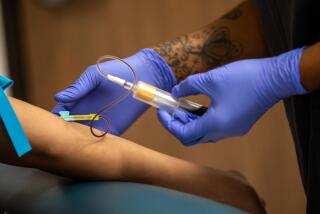20-Minute HIV Test Becomes Available in L.A.
- Share via
After months of anticipation -- and delay -- a rapid HIV test became available to the public Friday in California, allowing people to know in 20 minutes if they are infected with the deadly virus.
Until now, patients have had to wait days for test results. As a result, many of those tested for the human immunodeficiency virus never bothered to return to clinics to learn if they had the virus, which causes AIDS.
That has been a problem because those infected may not get timely treatment and may persist in risky sexual behavior that causes partners to become infected.
The new test, called OraQuick, is expected to help officials identify those infected more quickly and in greater numbers, making it easier to steer them toward treatment and safer sex practices. However, they caution that a positive test result is considered preliminary; another test is needed to confirm the result.
“Will the test live up to its promise? I don’t know,” said Dr. Robert Jannsen, director of HIV and AIDS prevention at the U.S. Centers for Disease Control and Prevention in Atlanta. “But it’s really critical that people learn their status, because when people learn they are HIV-positive, they reduce risk behavior.”
The test is a long time coming, its proponents say. Rapid tests have been commonly used overseas for several years. It was approved in this country in November, four years after health officials had declared its use an urgent need.
The test’s rollout after approval has been slowed by various factors, including its cost -- about $12 a test -- and the need to train testers and counselors in the new procedures.
Officials at the Los Angeles Gay and Lesbian Center said it was among the first clinics in the nation to offer OraQuick to the public, from its headquarters in Hollywood and a business in West Hollywood. Health-care advocates saw it as a welcome development because about 18% of the estimated 52,000 people with HIV in Los Angeles County don’t know they have the disease.
“The numbers are still increasing in some ethnic groups,” said Gustavo Aguilera, the center’s coordinator for HIV testing and counseling, between giving people their test results. “People are still getting infected, so something needs to change.”
Some people are glad for the opportunity to get the test -- and the anxiety over its results -- over with quickly.
“If you have to come back in a week for the results, you’re thinking about the test a lot; even if you’re probably negative, there’s still that fear,” said Julia, who stopped by for a test and asked that her last name not be used to preserve her privacy.
A clinician jabbed Julia’s finger with a short stick and squeezed the finger to get a small drop of blood into a vial. Julia, with a small bandage on her finger, was told to wait 20 minutes.
Even with the short wait, she admitted to being nervous. “Even though I’m over 99% sure of this being negative, it’s still horrifying,” she said.
Slowly, the test’s use is expected to expand. On Thursday, the CDC announced that it would spend $2 million to purchase 250,000 OraQuick tests, which then would be distributed to counties, cities and community groups across the nation.
In January, the Bush administration approved the use of the test outside of health clinics if clinics get the proper permission from the state -- a step that many public health officials had long pushed.
While tests previously were given in clinics, officials say OraQuick can be given elsewhere. Health officials hope to use it in a variety of settings, such as hospitals, jails, sex clubs and neighborhoods where higher numbers of infected people reside.
Still, the test is not yet in widespread use. Many HIV and AIDS groups have yet to receive permission to use it outside of a clinical setting. Others don’t have the money to buy the units.
Joanna Rinaldi, deputy director of the AIDS Health Project at UC San Francisco, and other health advocates said that they need time to develop the appropriate counseling for a test whose results come so fast. The best result, in Rinaldi’s mind, would be using the test sessions to educate more people about prevention.
“If you can get someone who uses a condom some of the time to use one most of the time, that’s way cool,” she said.
More to Read
Sign up for Essential California
The most important California stories and recommendations in your inbox every morning.
You may occasionally receive promotional content from the Los Angeles Times.













